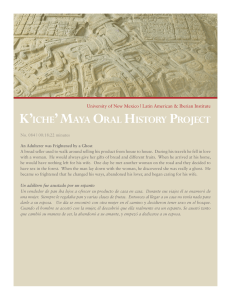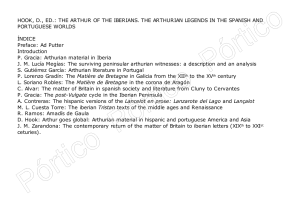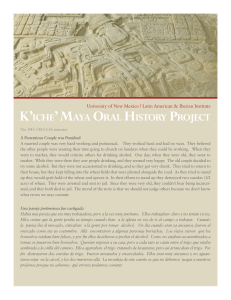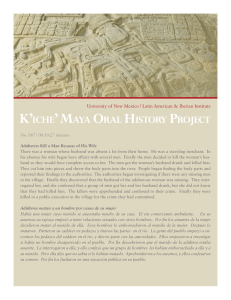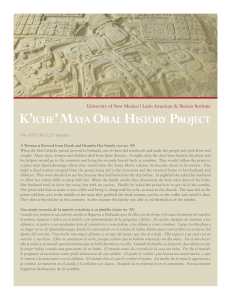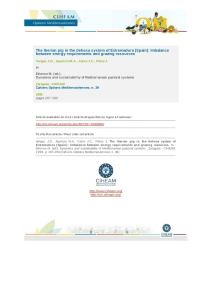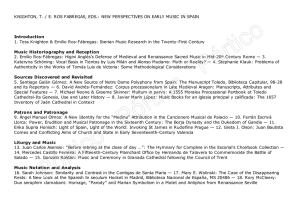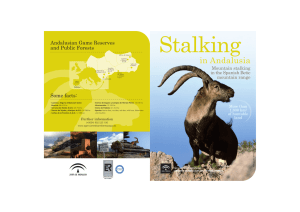This pdf of your paper in Celtic Art in Europe belongs to the
Anuncio
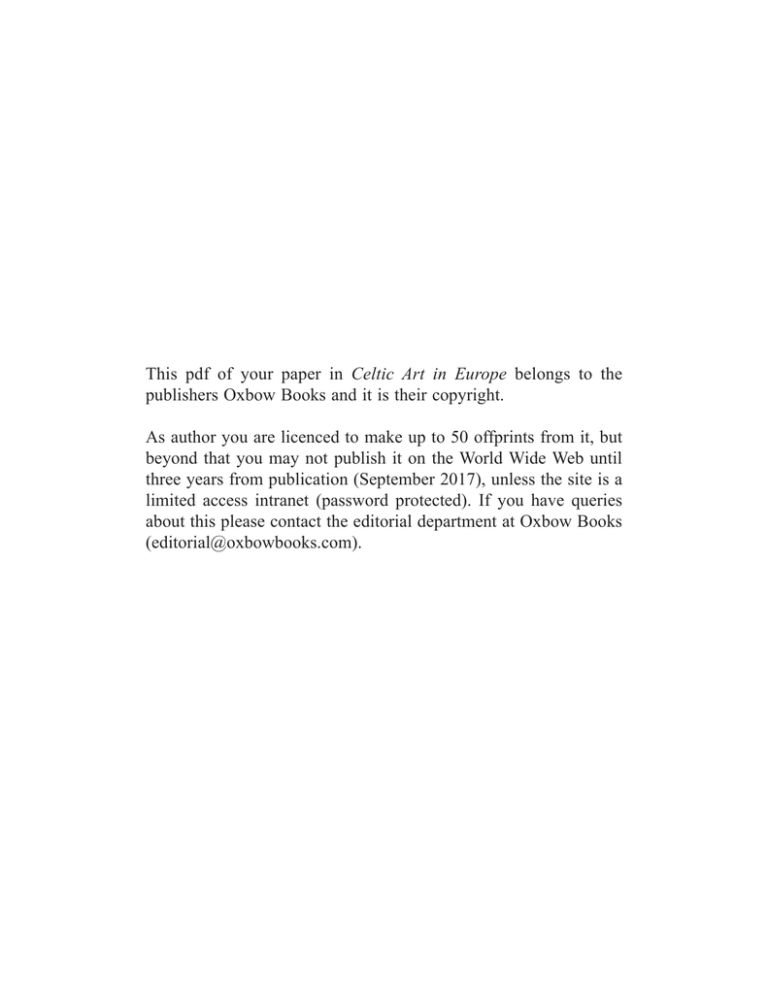
This pdf of your paper in Celtic Art in Europe belongs to the publishers Oxbow Books and it is their copyright. As author you are licenced to make up to 50 offprints from it, but beyond that you may not publish it on the World Wide Web until three years from publication (September 2017), unless the site is a limited access intranet (password protected). If you have queries about this please contact the editorial department at Oxbow Books ([email protected]). ii An offprint from CELTIC ART IN EUROPE making connections Essays in honour of Vincent Megaw on his 80th birthday Edited by Christopher Gosden, Sally Crawford and Katharina Ulmschneider Hardcover Edition: ISBN 978-1-78297-655-4 Digital Edition: ISBN 978-1-78297-656-1 © Oxbow Books 2014 Oxford & Philadelphia www.oxbowbooks.com Published in the United Kingdom in 2014 by OXBOW BOOKS 10 Hythe Bridge Street, Oxford OX1 2EW and in the United States by OXBOW BOOKS 908 Darby Road, Havertown, PA 19083 © Oxbow Books and the individual authors 2014 Hardcover Edition: ISBN 978-1-78297-655-4 Digital Edition: ISBN 978-1-78297-656-1 A CIP record for this book is available from the British Library Library of Congress Cataloging-in-Publication Data Celtic art in Europe : making connections : essays in honour of Vincent Megaw on his 80th birthday / edited by Christopher Gosden, Sally Crawford and Katharina Ulmschneider. pages cm Contributions in English, French, and German. Includes bibliographical references and index. ISBN 978-1-78297-655-4 1. Art, Celtic. I. Gosden, Chris, 1955- editor. II. Crawford, Sally (Sally Elizabeth Ellen) editor. III. Ulmschneider, Katharina, editor. IV. Megaw, J. V. S., honouree. N5925.C45 2014 704.03’916--dc23 2014021184 All rights reserved. No part of this book may be reproduced or transmitted in any form or by any means, electronic or mechanical including photocopying, recording or by any information storage and retrieval system, without permission from the publisher in writing. Printed in the United Kingdom by Berforts Information Press Ltd, Eynsham, Oxfordshire For a complete list of Oxbow titles, please contact: UNITED KINGDOM Oxbow Books Telephone (01865) 241249, Fax (01865) 794449 Email: [email protected] www.oxbowbooks.com UNITED STATES OF AMERICA Oxbow Books Telephone (800) 791-9354, Fax (610) 853-9146 Email: [email protected] www.casemateacademic.com/oxbow Oxbow Books is part of the Casemate Group Front cover: Oval-style massive armlet, Auchenbadie, Banffshire. © National Museums Scotland. Back cover: The statue from Glauberg, Hesse. Photograph courtesy of hessenARCHÄOLOGIE; Photo U. Seitz-Gray. CONTENTS Contributorsix 1. Introduction to Celtic Art in Europe: making connections Chris Gosden, Sally Crawford and Katharina Ulmschneider 1 2. Once again, Herodotus, the Κελτοί, the source of the Danube, and the Pillars of Hercules John T. Koch 6 3. The Sheffield origins of Celtic Art John Collis 19 4. Theorie der keltischen Kunst. Ein Versuch Felix Müller 28 5. Les codes de représentation visuelle dans l’art celtique ancien Laurent Olivier 39 6. Hidden faces and animal images on Late Iron Age and Early Roman horse harness decorated using the champlevé technique Jennifer Foster 7. The human masks of unknown provenience Mitja Guštin 8. Heads, masks and shifting identities: a note about some Danubian kantharoi with anthropomorphic decoration Mariana Egri 56 68 73 9. Off with their heads…! once again: images of daggers and severed heads on an Iberian falcata sword Fernando Quesada Sanz 86 10. A Celtic severed head, or Lazarus in the arms of Abraham? Natalie Venclová and Jan Royt 96 Contents v 11. Zur Attachenzier der Schnabelkannen von Basse-Yutz Otto-Herman Frey 101 12. The not so ugly duckling – an essay on meaning Flemming Kaul 105 13. Fragments of a carnyx from Leisach (Austria) Paul Gleirscher 113 14. Between ruling ideology and ancestor worship: the mos maiorum of the Early Celtic ‘Hero Graves’ Thomas Stöllner 119 15. Alfred and Alexander John Boardman 137 16. La fibule de Moscano di Fabriano: un jalon important de l’évolution de l’art celtique au IVe siècle avant J.-C Luana et Venceslas Kruta 140 17. Zum Wenden: der Halsring aus Gehweiler-Oberlöstern im Saarland Rudolf Echt 148 18. Late Hallstatt and Early La Tène gold and silver beads in southeast Pannonia Hrvoje Potrebica and Marko Dizdar 152 19. East meets West... The stamped pottery from the La Tène cemetery at Fântânele-Dealul Popii (Transylvania, Romania) Aurel Rustoiu 20. A vessel with stamped decoration from the Želiezovce collection Gertrúda Březinová 159 173 21. Balkan Kantharoi177 Petar Popović 22. La Tène and Przeworsk strap shield bosses from Poland Tomasz Bochnak 23. De l’anneau en bronze à têtes de béliers de Chermignac (Charente-Maritime) et de quelques pièces de harnais. La Tène finale de Gaule de l’Ouest José Gomez de Soto 183 196 24. A mould for Celtic-type rings from Sanzeno in the Valle di Non, Trentino Franco Marzatico 206 25. ‘Leopold Bloom I’ and the Hungarian Sword Style Paul Jacobsthal, with introduction by Katharina Ulmschneider and Sally Crawford 213 26. The Celtic mercenary reconsidered Jan Bouzek 223 27. The Dragon from Oberleiserberg Maciej Karwowski 234 vi Contents 28. A l’aube du IIIe s. av. J.-C.: les fourreaux d’épée à décor estampé sur fer Thierry Lejars 239 29. ‘…to boldly go where no man has gone before.’ Dedicated to Ruth and Vincent… 264 Boris Kavur and Martina Blečić Kavur 30. Art and Craftsmanship in elite-warrior graves: ‘from Boii to Parisii and back again…’ 274 Nathalie C. Ginoux and Peter C. Ramsl 31. Ascot hats: an Iron Age leaf crown helmet from Fiskerton, Lincolnshire? Andrew Fitzpatrick and Martin Schönfelder 286 32. Snettisham swansong I. M. Stead 297 33. The Iron Age open-air ritual site at Hallaton, Leicestershire: some wider implications Colin Haselgrove and Vicki Score 304 34. Brit-art: Celtic Art in Roman Britain and on its Frontiers Jody Joy 315 35. Art in context: the massive metalworking tradition of north-east Scotland Fraser Hunter 325 36. The Torrs Chamfrein or Head-piece: restoring ‘A very curious relic of antiquity’ C. Stephen Briggs 341 37. Vincent, in appreciation Mansel Spratling 356 J. V. S. Megaw: bibliography 361 Colour Plates 373 CONTRIBUTORS Martina Blečić Kavur Faculty of Humanities and Social Sciences, University of Rijeka, Croatia Mariana Egri Faculty of Ancient History and Archaeology, Babeş-Bolyai University of Cluj-Napoca, Romania John Boardman Beazley Archive, University of Oxford, United Kingdom Rudolf Echt Institut für Vor- und Frühgeschichte und Vorderasiatische Archäologie, Universität des Saarlandes, Saarbrücken, Germany Tomasz Bochnak Institute of Archaeology, University of Rzeszów, Poland Jan Bouzek Faculty of Arts, Masaryk University, Czech Republic Gertrúda Březinová Institute of Archaeology, Slovak Academy of Sciences, Nitra, Slovakia C. Stephen Briggs formerly Royal Commission on the Ancient Historical Monuments of Wales, Aberystwyth, United Kingdom John Collis Department of Archaeology, University of Sheffield, United Kingdom Sally Crawford Institute of Archaeology, University of Oxford, United Kingdom Marko Dizdar Institute of Archaeology, University of Zagreb, Croatia Andrew Fitzpatrick Wessex Archaeology, United Kingdom Jennifer Foster Department of Archaeology, University of Reading, United Kingdom Otto-Herman Frey Institut für Vor- und Frühgeschichte, Universität Marburg, Germany Nathalie C. Ginoux Institut d’art et d’archéologie, Université Paris-Sorbonne, France Paul Gleirscher Abteilung für Ur- und Frühgeschichte, Landesmuseum Kärnten, Klagenfurt, Austria José Gomez de Soto Laboratoire HeRMA, Université de Poitiers, France viii Contributors Chris Gosden Institute of Archaeology, University of Oxford, United Kingdom Laurent Olivier Département des âges du Fer, Musée d’Archéologie nationale de Saint-Germain-en-Laye, France Mitja Guštin Institute for Mediterranean Heritage, University of Primorska, Koper, Slovenia Petar Popović Institute of Archaeology, University of Belgrade, Serbia Colin Haselgrove School of Archaeology and Ancient History, University of Leicester, United Kingdom Fraser Hunter Department of Scottish History and Archaeology, National Museums Scotland, United Kingdom Jody Joy Department of Prehistory and Europe, The British Museum, London, United Kingdom Maciej Karwowski Institut für Ur- und Frühgeschichte, Universität Wien, Austria, and Instytut Archeologii, Uniwersytet Rzeszowski, Rzeszów, Poland Flemming Kaul Nationalmuseet, Copenhagen, Denmark Boris Kavur Institute for Mediterranean Heritage, University of Primorska, Koper, Slovenia John T. Koch Centre for Advanced Welsh and Celtic Studies, University of Wales, United Kingdom Luana Kruta Independent scholar, Paris, France Venceslas Kruta Centre national de la recherche scientifique (CNRS), Paris, France Thierry Lejars Ecole Normale Supérieure, Archéologies d’Orient et d’Occident et Science des Textes, Paris, France Franco Marzatico Castello del Buonconsiglio, monumenti e collezioni provinciali, Trento, Italy Felix Müller Abteilungen für Ur- und Frühgeschichte und Archäologie der Römischen Provinzen, Universität Bern, Switzerland Hrvoje Potrebica Faculty of Humanities and Social Sciences, University of Zagreb, Croatia Fernando Quesada Sanz Universidad Autónoma de Madrid, Spain Peter C. Ramsl Austrian Academy of Science, Commission for Prehistory c/o. Dept. for Prehistory, Natural History Museum, Vienna, Austria Jan Royt Institute of the History of Christian Art, Charles University Praha, Czech Republic Aurel Rustoiu Institute of Archaeology and History of Art, University of Cluj-Napoca, Romania Martin Schönfelder Römisch-Germanisches Zentralmuseum Mainz, Germany Vicki Score University of Leicester Archaeological Services, Leicester, United Kingdom Mansel Spratling Independent scholar, Cambridge, United Kingdom I. M. Stead Independent scholar, York, United Kingdom Thomas Stöllner Institut für Archäologische Wissenschaften, Ruhr-Universität Bochum, Germany Katharina Ulmschneider Worcester College, University of Oxford, United Kingdom Natalie Venclová Institute of Archaeology, Academy of Sciences of the Czech Republic, Praha, Czech Republic C. Gosden, S. Crawford, K. Ulmschneider (eds.) (2014) CELTIC ART IN EUROPE making connections Essays in honour of Vincent Megaw on his 80th birthday Oxford, Oxbow, pp. 86-95. 9 OFF WITH THEIR HEADS…! ONCE AGAIN: IMAGES OF DAGGERS AND SEVERED HEADS ON AN IBERIAN FALCATA SWORD Fernando Quesada Sanz The Iberian cemetery at Coimbra and burial 48 The archaeological complex at Coimbra (Jumilla, Mucia) includes a settlement surrounded by fortifications or cliffs encircling c.54 ha (only a fraction of this area was actually a built-up area, however), a sanctuary and three cemeteries, all of them partially excavated. The site falls squarely within the non Indo-European area of the Peninsula; in fact, it is one of the prototypical ‘Iberian Culture’ sites in Contestania-Bastetania, a region that covers a good part of the southeastern quadrant of modern Spain (Fig. 9.1b). Between 1995 and 2004 a grand total of 160 cremation burials were excavated in the cemetery of ‘El Poblado’, the one closest to the main entrance of the oppidum. The time span covered by this particular cemetery is c.400 to c.175 BC, with a reasonable equilibrium by generations (García Cano 1997; García Cano et al. 2008). Burial 48 contained the cremated remains of a single adult; sex could not be ascertained by the examination of the remains. The ashes and cremated bone fragments were deposited while still very hot in the bottom of shallow rectangular pit (1.6 m. × 1.1 m. × 0.30 m.) without a cinerary urn, together with a substantial set of grave goods and some cremated ovicaprine bones. The pit was then covered with a rectangular platform made of undressed stones, a sort of one-step tumulus typical of this region. The grave goods included two black glaze Attic vases (one 40D L kantharos and one 21L bowl) dated to c.350–325 BC, a coherent set of weapons (one falcata sword, one soliferreum, one shield, two horse spurs, a snaffle bit), some partly melted down faience decorative elements (perhaps from the shield body), a bronze brooch of the so-called La Tène I type but of typically Iberian manufacture, some Iberian pottery, at least six small bone awls, and some other badly preserved small metal (iron and copper alloy) remains. The weapons were carefully placed in the pit: first the soliferreum was bent in a figure-of-eight shape, the falcata was then laid over it, and finally the shield on top of them. Overall, it seems quite safe to assume that this was a masculine burial (further discussion on bone analysis, presence of weapons, sex identification and gender problems in Quesada Sanz 2011 and 2012). Tomb 48 is a very significant burial of above-average richness within the context of the cemetery. Grave goods include 17 objects, while the mean number of objects per burial in the cemetery is 8.1. Specifically, it is the third ‘richest’ burial deposited during the 4th century BC, quite above the statistical mode (9 objects) and mean, although the two really ‘rich’ burials of the 4th century BC contain 31 and 94 objects. No wealth-units analysis was performed (García Cano 1997, 93 ff.) but the qualitative analysis (multiple presence of imported pottery, complex set of weapons, horse harness) place this burial within the VIB (‘very important burials’) group, even if the structure of the grave itself is quite modest, not to be compared with the 94 objects and the imposing sculpted pillar-stele on top of the almost contemporary burial 70. The falcata sword and its decoration The falcata mentioned above as part of the burial is a typical example of this type of cut-and-thrust sword (the asymmetrical shape of its blade is deceptive). It has a horseshaped side guard/pommel, and its shape and relative size (blade length 56 cm; total length 67 cm) is typical of these swords at this time and in this region (Quesada Sanz 1997, 83 ff. for typological details). The falcata is not the typical Iron Age sword of the Peninsula; there are many other characteristic models in 9. Off with their heads…! once again: Images of daggers and severed heads on an Iberian falcata sword 87 a b Fig. 9.1. a: The two great linguistic and cultural areas of the Iberian Peninsula in the Iron Age combining different criteria (after J. Untermann 1995). b: Writing systems and diagnostic toponyms in ancient Iberia (c. 5th–1st century BC) (after P. Moret in Moret and Rouillard 1997, summarizing Untermann, Albertos and others). 88 Fernando Quesada Sanz different regions (e.g. Celtiberia). In fact, it is not even a typical ‘Iberian sword’: there are many Iberian-culture regions where falcatas are very rare, while La Tène type swords are more frequent, such as in Catalonia. Over 86 percent of all falcatas (more than 700 are known) have been found in south-eastern Spain (Quesada Sanz 1997, fig. 16). A few of them come from Iberian regions to the north (Valencia, Aragón, Catalonia) and west (western Andalusia), and very few have been documented in Celtiberia or Lusitania. In fact, most falcatas found outside the provinces of Córdoba, Jaén and Granada (in eastern Andalusia), and Albacete, Murcia, Alicante and southern Valencia (south-east) are fairly rare exceptions that can be safely be considered as imports from the nuclear area of production. The Coimbra falcata (Fig. 9.2) was richly decorated with silver inlay motifs along the blade fullers, and also in the wider proximal part of the blade, just under the hilt. These are typical places for decoration, and in this case the motifs were designed in what I’ve denominated the ‘free style’, fairly crude from the technical point of view, but displaying unusual, very individual elements rarely if ever found in the more detailed, rigid and perfectionist ‘precise style’ (see Quesada Sanz et al. 2000). Silver inlay tends to disappear under layers of iron corrosion, but modern restoration techniques and more systematic use of metallurgical X-ray testing show that a much higher number of Iberian swords than previously known were decorated with silver inlay technique, reaching perhaps 25 to 30 percent of the total number of falcatas. Only fragments of the original decoration remain, but it is clear that two long parallel bands, linked spirals forming ‘waves’ and zigzag lines, were inlaid with silver wire along the fullers and the base of the blade in the shape of a long ‘L’ (Figs 9.2, 9.3, 9.4). These motifs (Quesada Sanz nos. 1 and 9) are very common in Iberian metalwork but they are rare, especially in combination, in the Iberia Celtica. Also at the junction of the two branches of the ‘L’ shape another typically Iberian motif (n. 28) was inlaid (see Quesada Sanz 1997, figs. 66 and 69 for details). Far more interesting, and unique, are the three frontal human faces and the triangular dagger inlaid in the surface of the base of the blade (Figs 9.4 and 9.5). They were originally inlaid in both sides, but the reverse is badly preserved, and only the dagger is now visible on that surface (Fig. 9.6). X-ray images show in many cases that identical themes were depicted on both sides of a blade (see examples in García Cano and Gómez Ródenas 2006, burials 160, 198, 386, 597 etc., from the cemetery at Cabecido del Tesoro). As far as we know, these heads are in fact the only known anthropomorphic representations inlaid in the surface of falcatas. Animals (felines, boars, wolves, birds, even fishes) are attested, but human figures are so far unknown, except for this case. There are indeed a very few examples of three-dimensional human heads modelled as parts of the side-guards of hilts (e.g. La Serreta de Alcoi, burial 53, see Moltó and Reig 2000), but they are different in character and style. The three human faces – or heads – are placed together in a row. The one to the right is the best preserved (and the only one mentioned in the original publication: García Cano 1999, 44), but the other two are also discernible and seem to be almost identical (Fig. 9.4, insert). The faces measure about 0.8 cm in height (1.1 including beard) and are completely frontal. Head hair is not represented, but what looks very much like a beard marked by five lines is clearly visible. In fact, facial hair, although very uncommon in sculpture or reliefs, is occasionally shown in painted pottery (Ballester 1943 as dots or short lines). Nose, eyes and mouth are shown as very short straight lines, while eyebrows (or brow ridges) are clearly indicated as curved lines joined to the top of the nose. The ears are also very prominent, and are placed in a very high position. Very relevant to the interpretation of the row of heads is the dagger represented to their side (Fig. 9.5). It has a broad, triangular blade and the pommel is indicated by a short curved line, pointing upwards. This simplified depiction of a dagger (the blade is 1.1 cm, and the whole weapon is only 1.8 cm long) has some parallels in painted pottery. For example, the hero fighting a monster (in this case a sphinx) in a vase from Corral de Saus (Valencia) is shown wielding a spear in one hand, and a similar dagger in the other (Izquierdo 1995). But particularly, the vase from burial 400 at Cigarralejo (Cuadrado 1983), a cemetery very close both geographically and culturally to Coimbra, shows in black the silhouette of very similar daggers (Fig. 9.7). The vase can be dated to c.350 BC, was used as a cinerary urn in a warrior burial, and its decoration as a whole is unique, although the different icons appear elsewhere. All painted daggers in it show a similar broad triangular blade, but two pommel types can be distinguished, both easily recognizable in archaeological terms: the atrophied antennae and the frontón dagger (Quesada types IIA1 and IIB respectively, see Quesada 1997, 280 ff.). The broad, straight sided, triangular blades with either fronton or antennae pommels are typical of 5th to 4th century BC Iberian daggers. They have been found both in the Southeast and Andalusia, with some more isolated examples in Portugal (Alcacer do Sal, mouth of the river Tagus) and the western Meseta. They are also depicted in the great Porcuna monument (Negueruela 1990, plates XVIIIA, XXXVI). Interpretation We agree with the principle that ancient craftsmanship, prehistoric or classical, was not ‘art’ for the sake of aesthetic pleasure in itself, even in those works that clearly show a defined ‘style’ and a specific interest in producing aesthetically pleasant or visually impressive results, be it a 9. Off with their heads…! once again: Images of daggers and severed heads on an Iberian falcata sword 89 Fig. 9.4. Detail of the lower part of the hilt and proximal part of the blade, with anthropomorphic decoration (three human heads) and a dagger. (Author’s photo) Fig. 9.2. Iberian falcata from burial 48 at the ‘El poblado’ cemetery, Coimbra del Barranco Ancho, Jumilla, Murcia, Spain, c. 350–325 BC. (Author’s drawing) Fig. 9.3. Detail of the silver inlay decoration on the blade, along the fullers. (Author’s photo) Fig. 9.5. Detail of one of the human faces and the triangular dagger. (Author’s photo) 90 Fernando Quesada Sanz Fig. 9.7. Cinerary urn of burial 400 at El Cigarralejo (Mula, Murcia). (Photo Mula Museum). Fig. 9.6. Reverse of the blade, showing the blade of the dagger. The rest of the decoration, mirroring that of the other side of the blade, has been lost. (Author’s photo) biface, an Aphrodite or Hagia Sophia. Nor was ‘art’ conceived as a vehicle for expressing the artisan’s (or artist’s if we so wish) intentions, world view or desire to communicate. Minor or major objects that we now classify as works of art – and their decoration – were never purely ornamental, but were loaded with layers of abstract meaning that could and did accumulate one on of top of the other, both in daily life or in even more symbolically loaded contexts, such as funerary ritual. A boar inlaid in silver on the surface of a falcata (Quesada 1997, pl. IIID) could not only allude both to some physical characteristic of the weapon’s owner and to his bravery in battle, but also additionally play with his nickname, act as an heraldic symbol, and even add a funerary symbolism when the sword was deposited in his grave, or perhaps in his father’s or son’s. Of course much more sophisticated discussions can be added to this basic concept but this will suffice here (in the case of ‘Celtic’ art, centering on metalwork, see recently the inspiring work by Garrow and Gosden 2012, 38 ff.). Of course, we can accept a working definition of art as the ‘elements of decoration beyond those necessary for functional utility though these elements represent a form of symbolic visual communication which is only partially accessible to us’ as the Megaws humbly and succinctly put it years ago (Megaw and Megaw 2001, 9). In our opinion, the combination of heads and dagger in the Coimbra falcata is basically a direct allusion to victory in combat, and probably to the number of vanquished enemies, killed by the sword’s owner, probably (but not necessarily) the one who was cremated with it and buried in Grave 48, a quite important burial as we have described above, worthy of a respected and probably rich warrior. The dagger complements the images of the severed heads; in fact this is the only image of a weapon on a real Iberian weapon, interestingly enough, as it seems to indicate that there is a specific connection with the human severed heads. We do not know if this particular falcata was specifically forged and decorated for the grave. In fact, we suspect it was not. We do know that in Antiquity many richly decorated weapons were carried into battle and were perfectly functional, as this falcata certainly was. So it is quite possible that its proud owner carried it many times before his death. It is even possible that it was originally forged without that particular decoration, or without any decoration at all. We do know that the smiths who forged swords were not necessarily those who 9. Off with their heads…! once again: Images of daggers and severed heads on an Iberian falcata sword decorated them with fine silver motifs, and most probably they almost never were blacksmiths and silversmiths at the same time (Quesada et al. 2000). Our impression is that the geometric motifs along the fullers could have been inlaid first, and that heads and dagger could have been added later, the weapon being displaced to the right for lack of space (Fig. 9.5). This phenomenon has parallels elsewhere (see examples in Celtic swords in Garrow and Gosden 2012, 132–133). The idea of ‘counting heads’ as proof of victory in History, from ancient Egypt to Vietnam, from Assyria to the Americas, is of course so common and well-known it needs no further discussion here; it has nothing particularly ‘Iberian’ or even ‘Celtic’ in it (Sterckx 2005, 53–103 proves the point while concentrating of the Celtic variants of this practice). The Iberians were probably not alien to this custom: Diodorus Siculus describes the siege of Selinous in Sicily in 409 by a mercenary Carthaginian army. Hannibal launched successive assaults by different contingents, first the Campanians (13.55.7) and other peoples, but it was the Iberians who finally took the city (13.56.6). The conquerors, ‘according to the practice of their people, mutilated even the dead, some carrying bunches of hands about their bodies and other heads which they had spitted upon their javelins (saunia) and spears (gaesa)’ (13.57.3). It is however true that our source does not specifically mention that it was the Iberians who did this, and it seems likely (contra Sterckx 2005, 89; Marco 2006, 201) that he had the Gauls in mind, as he had already mentioned this custom in his discussion of their customs (5.29.4) see also Aguilera 2013). Some would also cite the names of the weapons that Diodorus mentions as additional evidence for this. However, the idea of displaying images of specific numbers of weapons or of body parts as some kind of ‘statistic’ is not so common, but is also documented. We should recognize however that it is weapons, and not human parts, that are usually employed for ‘body counts’. In the case of the Iberians, Aristotle specifically states (Politics 7.2.11 – 1324b) that ‘among the Iberians, a warlike people [Ibersin, ethnei polemikoi], they fix spears [obeliskoi] in the earth round a man’s grave corresponding in number to the enemies he has killed’. Admittedly, Aristotle never went to Iberia, but his master Plato did travel to Sicily at least three times between 387 and 361 BC, and met Iberian mercenaries in Syracuse (Plato Epistles 7.348a). A curious man, he could have obtained some first-hand information there and told about it later in Athens. This literary reference is not our only hint: there is evidence of small numbers of spearheads stuck vertically in a number of Iberian (and Celtiberian) burials. Last but not least, there is a series of Late Iberian incised stone stelae that depict rows of spears or spearheads, although it is unlikely that they were meant to show the exact number of enemies killed in combat (see Quesada 1997, 424 ff. and figure 250; most recently, Marco and Royo 2012, 315–16). In this respect, the Iberian funerary pillar-stele from Caspe 91 (López Monteagudo 1983; Pérez Rojas 1983) is worth a brief comment. On top of the monument a stone lion sculpted partly in the round, partly in relief, crowns a square section pillar that displays a rather long but fragmentary text in Iberian script, unreadable – as all of them are – but perhaps originally mentioning two to four personal names. Between the inscription and the lion, four shields (three caetrae and one oval thureos) are represented. These shields could belong to the people mentioned in the inscription (supposing the interpretation is correct, but see de Hoz 2011, 321 ff.) but another possibility is available. In epigraphic cultures whose texts we can read, things become somewhat easier: for example, the great commemorative pillar from Xanthos in Lycia shows a row of seven aspides (hoplite round shields), a fallen warrior and a standing one. The long inscription on the northern side of the pillar tells the story: seven Arcadian hoplites were defeated by the Lycian prince, and the weapons represent them (Demargne 1958, 79–103). As we have mentioned above, this basic meaning could have been complemented and enriched with other added meanings, probably even in the funerary context in which the sword finally met its resting place. Among them, an apotropaic symbolism seems likely (see below). The Peninsula: Falcatas, Iberians and Celticspeaking peoples The palaeoethnology of the Iberian Peninsula during the Iron Age is a very complex affair (Almagro and Ruiz Zapatero 1992), but epigraphy and its associated disciplines toponymy and onomastics have long proved (see Untermann 1963 refined many times afterwards, Fig. 9.1a) the existence of two main linguistic areas, marked by a roughly diagonal, undulating buffer zone running northeast to southwest, basically along the mountain ranges separating the Mediterranean and Atlantic watersheds. To the west and north of this line different variants of Indo-European languages are attested. This area corresponds with regions inhabited by different pre-roman peoples known to ancient writers as Celtiberi, Vaccaei, Vettones, Celtici and a long etcetera. To the east and south of this linguistic – but also archaeological – frontier (Catalonia, Lower Ebro valley, Mediterranean coastal regions and most of Andalusia), the different pre-Roman inhabitants spoke a non-Indo-European language (or languages) collectively known as Iberian and probably Turdetanian in western Andalusia. There is a long list of known ethnonyms for these peoples (including, from south to north, the Turdetani, Bastetani, Contestani, Edetani, Ilercavones, Ilergetes, Laietani and Indicetes), which are conveniently grouped into two archaeological ‘cultures’: Turdetanians in western Andalusia and Iberians all along the Mediterranean façade and into southern France. With all its limitations, this basic division still stands as a useful 92 Fernando Quesada Sanz instrument for basic research and description (e.g. Lorrio and Ruiz 2005a; Lorrio 2011; Moret and Rouillard 1997) (Fig. 9.1b). Some – perhaps most – languages in the Central, Western and Northern parts of the Peninsula were thus of IndoEuropean lineage, and some of them are undoubtedly Celtic in character (e.g. Celtiberian), while there is still much discussion on others (e.g. Lusitanian, see de Hoz 2011, 563 ff.). On the other hand, all serious linguists agree that Iberian is certainly not an Indo-European language (e.g. Untermann, 2001; de Hoz 2010; 2011). Also, almost all specialists maintain that the dates and geographical extension of Iberian epigraphy closely match what archaeologists call ‘Iberian Iron Age culture’ from the point of view of material remains, including architecture, pottery, weapons and other artifacts, together with more elusive concepts such as economy or patterns of territorial control. Thus, the Iberian Culture is basically neither Indo-European nor Celtic in language or material culture. Têtes coupées, Celts and Iberians How should we then interpret the severed heads in the Coimbra falcata? As an Iberian element, or as proof of strong Celtic influence? Most Celtic scholars allow for the Mediterranean origin (mostly Etruscan) of many of the images of faces and heads in early Celtic Art (e.g. Megaw and Megaw 2001, 70), or at least pay lip service to that iconographical debt before moving on into a truly ‘Celtic’ head-and-face fixation. In the case of Coimbra, the cultural and archaeological context, and the weapon itself, are purely Iberian. But some scholars (e.g. Lenerz de Wilde 1986) have seen a strong La Tène influence not only in some decorative patterns in Celtiberian metalwork, but also in clearly Iberian weaponry, including some motifs such as linked lyres and palmettes, or ivy leaves, that are rare or absent in Celtiberian weapons. It is certainly possible to view these elements as ‘Celtic’, but it is a much more economical hypothesis to acknowledge – as most scholars do – that Celtic art is an amalgam of many elements, many of them originally Etruscan or Italian, interpreted according to its own logic (e.g. Megaw and Megaw 1989, 20ff. 70 ff.; Garrow and Gosden 2012, 40). Iberian art was also subject to the same influences, and the falcata type itself has an original Italic provenance (Quesada 1997, 123 ff.). But the problem of severed heads as a custom remains, leaving aside the subject of certain ornamental motifs. Most European archaeological literature tends to see the ‘tête coupée’ phenomenon during the Iron Age as an almost purely Celtic cultural trait. It is perhaps striking that some of the early papers on the subject emphasize the ‘Mediterranean connections’ (Benoit 1949; 1969), while later works insistently remark the words ‘rite celtique des têtes coupées’ (Chassaing 1976 among many others). In many cases it has acquired the rank of a distinguishing feature of the Gauls in particular. Most manuals on the Celts display specific entries on ‘heads’ in their indexes, often with specific subheadings in which some emphasis is put on ‘severed heads’ (e.g. Megaw and Megaw 1989; James 1993; Green 1993; Cunliffe 1997 etc.). But these entries hide an often bewildering variety of sources (literary, iconographic, osteological), and of subjects (references to decapitation of fallen enemies in literary sources, exhibition of crania in sanctuaries or even the façades of houses, crowned heads, stylized decorative motifs in the form of human heads, sculptures in which heads, severed or otherwise are shown as part of a more complex theme, and a long etcetera). These objects, images or literary citations may or may not have a related meaning, except in that their central theme is the human head or the human face, disembodied but not necessarily the severed head of a particular individual. At the bottom of every single explanation, of course, lies the fact, already explained by Plato, that the human head is the most divine part of us (Plato, Timaeus 44d). The apotropaic virtues of preserved heads or crania have been a preferred explanation for ritual decapitation (Sopeña 1987, 103 ff.), and this apotropaic explanation is often extended to human faces in many different Celtic and Celtiberian contexts, from jewellery to monumental stone sculpture (Harding 2007, 54; Alfayé 2011, 200). In some of these cases, human heads could have been those of heroes, ancestors or gods, a very different proposition (see recently on the human sculptures in Southern France and their meaning, Py 2001, 119 ff.; McCartney 2012, 74 ff. in which the contradiction between interpretation as sculpted ancestors and decapitated enemies is very much in evidence). Finally, the idea of a ‘head worship’, a cult centered on the human head as such (e.g. Llanos 2007), should be treated with healthy scepticism, in the Keltike and elsewhere (see a summary of different views on this in Alberro 2003–4, 217–18 and a shorter one in McCartney 2012, 82). On the other hand, the specific explanation of the beheading of defeated enemies as a means of symbolically killing his soul and identity, of destroying his hopes of life in the netherworld and of controlling his spirit (e.g. Brunaux 1986, 110–111; Dedet 2011, 288), has also long been prevalent, and some authors have even unfairly reproached classical authors for leaving the ritual aspect of this practice unexplored (Richtie and Richtie 1995, 54). But some recent work is also returning to what many ancient sources actually say about mutilation of enemies as a straightforward means of inflicting heavy indignity on his remains (Alfayé 2004, 71 ff.). The amputation of hands is in this respect closely related to decapitation (e.g. Sopeña 2008; Alfayé 2004; Green 2006, 298 ff.; Marco 2006, 201). A certain economic value, a ‘valeur marchande’ of severed heads as proof of victory or of treason has also been suggested (Brunaux 2004, 112). The same author, using ancient literary sources, has recently criticized the idea that 9. Off with their heads…! once again: Images of daggers and severed heads on an Iberian falcata sword the Gauls inflicted humiliation on the severed heads of their defeated enemies, as the Romans or Scythians did; to Brunaux, ‘la tête connaît un sort gratifiant’ (2012, 107). In the Iberian Peninsula there is a long tradition of studies on the tête coupée, mostly – but not always – from a Celtic perspective (Taracena 1943; Balil 1956; Blázquez 1958; 1961; Pujol 1979–80; López 1987; Sopeña 1987, 99 ff.; Díaz 1989; Almagro and Lorrio 1989; Alberro 2003–4; Llanos 2007). Only a perceptive – and still unpublished – paper criticizes systematically the excessive focus placed on Celtiberia while at the same time discarding the opposition between ‘Iberian’ and ‘Celtic’ (Aguilera 2013). Some human crania, originally fixed with strong iron nails to walls, have been found in Iberian sites such as Ullastret, Illa d’en Reixac or Molí de Espígol (Gerona), close to Southern Gaul, and have therefore been interpreted according to the Celtic tradition of defeated enemies (see Hermary 2003; Agustí, Lara and Martín 2010; Ciesielki et al. 2011; Codina et al. 2011). Other crania from Numantia in Celtiberia, far from Catalonia, are however obviously related to it (Taracena 1943). Recent work believes that some of these crania might have been not only those of enemies, but also of ancestors, obviously to be placed in different contexts (Ciesielki et al. 2011, 116). Their interpretation has reached a high degree of complexity and even confusion, leading to a very specific Conference on the subject, aptly titled ‘Crânes trophées, cranes d’ancêtres et autres pratiques autour de la tête’ (Boulestin et al. 2012). Images of disembodied human heads also appear in Celtiberian horse-fibulae. These are often shown just in front of the miniature horses that form the body of the brooch, as if they were suspended from the horse’s neck (Almagro and Torres 1999, 72 ff.). Of course, this is just what Diodorus says Gauls did to their victims (see above), but it is also exactly what Assyrian cavalry did to theirs in Ashurnasirpal’s II time (Yadin 1963, 385). Although Occam’s razor counsels to choose the influence that is close in time and space, and it is reasonable to consider these horse-fibulae with trophy heads as ‘one of the most characteristic subjects of Celtic Art in the Iberian Peninsula’, the fact that this seems to be an almost universal practice should not be forgotten. An article by E. Knauer has shown indeed how frequent the custom of suspending heads from the neck of horses has been (Knauer 2001). Miranda Green has recently suggested that these brooches could be perhaps also understood within the realm of a ‘mythologised conflict’ as it seems to be the horses that take iconographic precedence (Green 2010, 197), an example of these possible ‘layers of meaning’ we have mentioned above. Therefore we should not use these fibulae – or any other Celtiberian object with a similar motif – to argue that the severed human heads on the Coimbra falcata reflects ‘Celtic’ influence of any kind, other than a common perception of the significance of this part of the human body in many different 93 contexts. In fact, some authors have recently pointed out that most of the most explicit images of decapitation come from Iberian – Aragonese – and not from Celtiberian contexts. This is the case of the stone stelae from El Palao (Alcañiz) and La Vispesa (Huesca) (Marco Simón 2006, 201) both displaying explicit scenes of victory. Aguilera has recently added that the evidence of human crania in other Iberian sites such as La Alcudia (Elche) renders a purely Celtiberian or Celtic interpretation of the ‘têtes coupées’ in the Peninsula very questionable. Conclusion We have argued elsewhere (Quesada 2005): (a) that it is a serious mistake to apply La Tène categories, types and chronologies to the Iberian Peninsula affairs in general, and to weapons in particular (see also recently García Jiménez 2012). The Peninsula has a strong and distinctive personality that does not allow for simplistic extrapolations (see also Lorrio and Ruiz 2005b, 44). (b) That – due to the history of research – it has often been argued that the Celtic areas of the Iberian Peninsula, supposedly more warlike, heavily influenced Iberian weapon design and evolution, while in fact the opposite is generally true. Both these arguments are relevant to our present case, and while widely accepted, are often forgotten. I would particularly emphasize that while some La Tène-type objects or decorative elements may appear from time to time in Iberian contexts, they are mostly isolated cases (except in northeastern Catalonia) and should not be taken as proof of anything like strong Celtic presence or influence. In the case of our falcata, it might be tempting to see the images of the severed heads as part of the supposedly Celtic (or even Gaulish) ‘tête coupée’ phenomenon. I believe that this would be a mistaken approach, and that the decoration should be interpreted in purely ‘Iberian’ terms. Beheading vanquished enemies, the display of their heads and crania with both an apotropaic meaning and the intention to humiliate the memory of the fallen enemy; the depiction of heads as a means of boasting and calling attention to one’s own accomplishments, these are all activities close in meaning and aspect to similar Celtic and Mediterranean customs and traditions, but can be more easily explained in terms of convergence rather than of external influence. Acknowledgements I am grateful to Dr. Jose Miguel García Caro (Universidad Murcia) for his kind permission to study the weapons even when they were originally still unpublished, and for the time spent discussing Iberian cemeteries. Any mistakes that might remain are exclusively mine. 94 Fernando Quesada Sanz Bibliography Aguilera Durán, T. 2013 (forth.). El rito celta de las cabezas cortadas en Iberia: revisión de un tópico historiográfico. In F. Burillo (ed.) VII Simposio sobre los Celtíberos. Nuevos hallazgos. Nuevas interpretaciones. Daroca: Marzo 2012. Agusti Farjas, B., Lara, L. and Martín, A. 2010. Restauració i reestudi antropològic de quatre cranis del Museu d’Ullastret, Cypsela 18, 307–19. Alberro, M. 2003–2004. El paradigma céltico de las cabezas cortadas y su conexión con la diosa de guerra ornitomórfica y los ritos funerarios de los celtíberos. Homenaje a R. Lucas Pellicer, Kalathos 22–23, 195–249. Alfayé Villa, S. 2004. Rituales de aniquilación del enemigo en la Estela de Binéfar (Huesca), Actas del XXVII Congreso Internacional Girea-Arys IX. Jerarquías religiosas y control social en el mundo antiguo, Valladolid, 2002, 63–74. Valladolid. Alfayé Villa, S., 2011 Imagen y ritual en la Celtica peninsular. Noia, ed Toxosoutos. Almagro-Gorbea, M. and Lorrio Alvarado, A. 1989. Represent­ aciones humanas en el arte céltico de la Península Ibérica. Actas del II Symposium de Arqueología Soriana, I, 409–52. Soria. Almagro-Gorbea, M. and Ruiz Zapatero, G. (eds.) 1992. Paleoetnología de la Península Ibérica, Actas de la reunión celebrada en la Facultad de Geografía e Historia de la Universidad Complutense de Madrid, 1989, Complutum 2–3. Madrid. Almagro-Gorbea, M. and Torres Ortiz, M. 1999. Las fíbulas de jinete y de caballito. Aproximación a las élites ecuestres y su expansión en la Hispania céltica. Zaragoza: Institución Fernando el Católico. Balil, A. 1956. Representaciones de cabezas cortadas y cabezastrofeo en el Levante español, IV Congreso Internacional de Ciencias Prehistóricas y Protohistóricas, 871–79. Zaragoza. Ballester Tormo, I. 1943. Las barbas de los Iberos. Notas sobre la cerámica de San Miguel de Liria, Ampurias 5, 109–16. Benoit, F. 1949. L’aire mediterranéenne de la tête-coupèe, Rivista di Studi Liguri XV, 243–55. Benoit, F. 1969. Gorgone et tête coupée, du rite au mythe, Archivo Español de Arqueología 42, 81–93. Blázquez Martínez, J. M. 1958. Sacrificios humanos y representaciones de cabezas en la P. Ibérica, Latomus 19, 27–48. Blázquez Martínez, J. M. 1961. Cabezas cortadas inéditas del Castro de Yecla (Salamanca), VII Congreso Nacional de Arqueología, 217–26. Zaragoza. Boulestin, B. and Gambier, D. H. (eds.) 2012. Crânes trophées, crânes d’ancêtres et autres practiques autour de la tête: problèmes d’interpretation en archéologie, BAR International Series 2415. Oxford: Archaeopress. Brunaux, J. L. 1986. Les Gaulois. Sanctuaires et rites. Paris: Errance. Brunaux, J. L. 2004. Guerre et religion en Gaule. Essai d’anthropologie celtique. Paris: Errance. Brunaux, J. L. 2012. Du prix et des usages de la tête. Les données historiques sur la prise du crâne en Gaule. In B. Boulestin and D. H. Gambier (eds.) Crânes trophées, crânes d’ancêtres et autres pratiques autour de la tête: problèmes d’interprétation en archéologie, BAR Interational Series 2415, 107–116. Oxford: Archaeopress. Chassaing, M. 1976. Du rite celtique des têtes coupées et de sa survivance dans l’iconographie gallo et germano-romaine, XX Congrés Prehistorique de France 1974, 69–81. Paris: Société Préhistorique Française. Ciesielki, E., Duday, H., Girard, B., Roure, R., Martin, A. and Agusti, B. 2011.La pratique des têtes coupées et les dépôts d’armes en Gaule méditerraneenne et dans le nord-est de la Péninsule Ibérique. In R. Roure and L.Pernet (eds.) Des rites et des homme:. Les pratiques symboliques des celtes, des Ibères, et des Grecs en provence, en Languedoc et en Catalogne, 112–145. Paris: Errance. Codina, F., Martin, A., Prado, G. de and Agustí, B. 2011. Ullastret. Baix Empordà, Catalogne. In R. Roure and L.Pernet (eds.) Des rites et des hommes. Les pratiques symboliques des celtes, des Ibères, et des Grecs en provence, en Languedoc et en Catalogne, 158–163. Paris: Errance. Cuadrado Díaz, E. 1983. Una decoración excepcional en la cerámica ibérica. In Homenaje al Prof. Martín Almagro Basch III, 57–67. Madrid. Cunliffe, B. W. 1997. The Ancient Celts. Oxford: University Press. De Hoz Bravo, J. 2010. Historia lingüística de la Península Ibérica en la Antigüedad, I. Preliminares y mundo meridional prerromano, Anejos de Emerita L. Madrid: CSIC. De Hoz Bravo, J. 2011. Historia lingüística de la Península Ibérica en la Antigüedad, II. El mundo ibérico prerromano y la indoeuropeizació, Anejos de Emerita LI. Madrid: CSIC. Dedet, B. 2011. La tête coupée, symbole de mise à mort suprême en Gaule méridionale? Des textes anciens aux données de l’archéologie. In P. Gruat and D. Garcia (eds.) Stèles et statues de l’Age du Fer; Documents d’Archéologie Méridionale 34, 281–9. Demargne, P. 1958. Fouilles de Xanthos I. Les piliers funéraires. Paris: Institut Français d’Archéologie d’Istambul. Díaz Sanz, M. A. 1989. Sacrificios humanos en la Celtiberia Oriental: las ‘cabezas cortadas’. II Encuentro de Estudios Bilbilitanos, Calatayud 1986, I, 33–41. Calatayud. García Cano, J. M. 1997. Las necrópolis ibéricas de Coimbra del Barranco Ancho (Jumilla. Murcia). I. Las excavaciones y estudio analítico de los materiales. Murcia: Universidad de Murcia. García Cano, J. M. 1999. Las necrópolis ibéricas de Coimbra del Barranco Ancho (Jumilla. Murcia). II. Análisis de los enterramientos, catálogo de materiales y apéndices. Murcia: Universidad de Murcia. García Cano, J. M. and Gómez Ródenas, M. A. 2006. Avance al estudio radiológico del armamento de la necrópolis ibérica del Cabecico del Tesoro (Verdolay, Murcia) I. Las falcatas, Gladius 26, 61–92. García Cano, J. M.; Page, V.; Gallardo, J.; Ramos, F.; Hernandez, E. 2008. El mundo funerario ibérico en el Altiplano JumillaYecla (Murcia): la necrópolis de El Poblado de Coimbra del Barranco Ancho. Investigaciones de 1995–2004. Vol. II. Murcia. García Jiménez, G. 2012. El armamento de influencia la Tène en la Península Ibérica (siglos V–I a.C.), Monographies Instrumentum 43. Montagnac: Eds. M. Mergoil. Garrow, D. and C. Gosden. 2012. Technologies of Enchantment? Exploring Celtic art 400 BC to AD 100. Oxford: Oxford University Press. Green, M. 1993. The Gods of the Celts 2nd ed. Stroud: A. Sutton. 9. Off with their heads…! once again: Images of daggers and severed heads on an Iberian falcata sword Green, M. 2006. Semiologies of subjugation: the ritualisation of War-prisioners in later European Antiguity. In T. Otto, H. Thrane and H. Vandkilde (eds.) Warfare and Society. Archaeological and Social Anthropological perspectives, 281–304. Aarhus: University Press. Green, M. 2010. La religión celtibérica desde la religión céltica. In F. Burillo (ed.) Ritos y mitos, VI simposio sobre Celtíberos, 189–204. Zaragoza. Harding, D. W. 2007. The Archaeology of Celtic Art. London: Routledge. Hermary, A. 2003. Grecs et Barbares cloueurs de têtes: compléments au temoinage de Poseidonios, Hommage a Guy Barruol. Suppl. Revue Archéologique de Narbonnaise 35, 525–30. Izquierdo Peraile, I. 1995. Un vaso inédito con excepcional decoración pintada procedente de la necrópolis ibérica de Corral de Saus (Moixent, València), Homenatge a Milagros Gil-Mascarell, Saguntum 29, 93–104. James, S. 1993. Exploring the world of the Celts. London: Thames and Hudson. Knauer, E. R. 2001. Observations on the ‘Barbarian’ custom of suspending the heads of vanquished enemies from the neck of horses, Archaologische Mitteilungen aus Iran 33, 283–332. Lenerz de Wilde, M. 1986. Art celtique et armes ibériques, Aquitania Suppl. 1, 273–80. López Monteagudo, G. 1983. La estela de Calpe y los pilares-estela ibéricos, Archivo Español de Arqueología 56, 261–5. López Monteagudo, G. 1987. Las ‘cabezas cortadas’en la Península Ibérica, Gerión 5, 245–52. Lorrio Alvarado, A. J. 2011. Los celtas en el Occidente de Iberia. In G. Ruiz Zapatero and J. Alvarez Sanchís (eds.) Castros y Verracos, 45–100. Avila: Diputación provicial. Lorrio Alvarado, A. J. and Ruiz Zapatero, G. 2005a. The Celts in Iberia: an overview. E-Keltoi 6, 167–254. (=http://www4.uwm. edu/celtic/ekeltoi/volumes/vol6/6_4/lorrio_zapatero_ 6_4.pdf). Lorrio Alvarado, A. J. and Ruiz Zapatero, G. 2005b. Celtiberians: Archaeology of Celts in Iberia. In W. Gillies and D. W. Harding (eds.) Celtic Connections, Papers from the Tenth Intrnational Congress of Celtic Studies, Edinburgh 1995, Volume 2, 33–55. Edinburgh: University of Edinburgh. Llanos Ortiz, A. 2007. El rito de las cabezas cortadas en el poblado de La Hoya (Laguardia, Alava), Homenaje a I. Barandiarán, Veleia 24–25, 1273–81. Marco Simón, F. 2006. Intimidación y terror en la época de las Guerras Celtibéricas. In G. Urso (ed.) Terror et pavor, 197–213. Pisa: ETS. Marco Simón, F. and Royo Guillén, J. I. 2012. Iconografía entre la Primera Edad del Hierro y la Romanización: nuevos documentos y nuevas lecturas. In C. Belarte et al. (eds.) Iberos del Ebro, 305–20. Tarragona: ICAC. Megaw, M. R. and Megaw, J. V. S. 2001. Celtic Art: From its beginnings to the Book of Kells, 2nd ed. London: Thames and Hudson. Moltó Gisbert, S. and Reig Seguí, C. 2000. La falcata de la sepultura 53 de la necròpolis de la Serreta i el seu context arqueològic, La falcata ibérica de La Serreta, 31–43. Alicante. Moret, P. and Rouillard, P. 1997. Les Ibères. In Les Ibères, Dossiers d’Archèologie 228, 4–13. Dijon. McCartney, M. 2012. Warfare and Violence in the Iron Age of Southern France. BAR International Series 2403. Oxford: Archaeopress. 95 Negueruela, I. 1990. Los monumentos escultóricos ibéricos del Cerrillo Blanco de Porcuna (Jaén). Madrid: Ministerio de Cultura. Pérez Rojas, M. 1983. La estela ibérica de Caspe: introducción a su estudio lingüístico, Archivo Español de Arqueología 56, 269–85. Pujol Puigvehi, A. 1979–80. Los cráneos de Ullastret y su posible significado, Pyrenae 15–16, 267–75. Py, M. 2011. La sculpture gauloise méridionale. Paris, Errance. Quesada Sanz, F. 1997. El armamento ibérico. Estudio tipológico, geográfico, funcional, social y simbólico de las armas en la Cultura Ibérica (siglos VI–I a.C.), Monographies Instrumentum 3. Montagnac: Ed. Monique Mergoil. Quesada Sanz, F. 2005. Patterns of Interaction: ‘Celtic’ and ‘Iberian’ weapons in Iron Age Spain. In W. Gillies and D.W. Harding (eds.) Celtic Connections. Papers from the Tenth Intrnational Congress of Celtic Studies, Edinburgh 1995, Volume 2, 56–78. Edinburgh: University of Edinburgh. Quesada Sanz, F. 2011. Au-delà du guerrier: signification et fonction de l’armement dans les tombes féminines et d’immatures dans la Péninsule ibérique au second âge du Fer. In L. Baray, M. Honneger and M. H. Dias-Meirinho (eds.) L’armement et l’image du guerrier dans les societés anciennes. De l’objet à la tombe, Actes Table Ronde, Sens-CEREP, 4–5 Juin 2009, 337–54. Dijon: Eds. Universitaires. Quesada Sanz, F. 2012. Mujeres, amazonas, tumbas y armas: una aproximación transcultural. In L. Prados Torreira (ed.) La arqueología funeraria desde una perspectiva de género, 317–64. Madrid: UAM. Quesada Sanz, F.; Zamora, M.; Requena, F. 2000. Itinerant smiths in the Iberian Iron Age? (6th–2nd centuries BC). In M. Feugère and M. Gustin (eds.) Iron, Blacksmiths and Tools, Monographies Instrumentum 12, 15–19. Montagnac: Ed. Monique Mergoil. Richtie, J. N. G. and Richtie, W. F. 1995. The army, weapons and fighting. In M. J. Green (ed.) The Celtic World, 37–57. London-New York: Routledge. Sopeña Genzor, G. 1987. Dioses, ética y ritos. Aproximaciones para una comprensión de la religiosidad entre los pueblos celtibéricos. Zaragoza. Sopeña Genzor, G. 2008. Acerca de la amputación de la mano diestra como práctica simbólica. El caso de Hispania en época de las guerras celtibérico-lusitanas. In F. Cadiou, M. A. Magallón and M. Navarro (eds.) La guerre et ses traces, Saldvie 8, 271–83. Sterckx, C. 2005. Les mutilations des ennemis chez les Celtes préchrétiens. Paris: L’Harmattan. Taracena Aguirre, B. 1943. Cabezas-trofeo en la España céltica, Archivo Español de Arqueología 16, 150–171. Untermann, J. 1963. Estudio sobre las áreas lingüísticas prerromanas de la Península Ibérica. Archivo de Prehistoria Levantina 10, 165–192. Untermann, J. 1995. Lengua y poblamiento prerromano en el territorio celtibérico. In F. Burillo (ed.) Poblamiento celtibérico, III Simposio sobre los Celtíberos, Daroca, 7–24. Zaragoza: Inst. Fernando el Católico. Untermann, J. 2001. La toponimia antigua como fuente de las lenguas hispano-celtas, Palaeohispanica 1, 187–218. Yadin, Y. 1963. The Art of Warfare in Biblical Lands in the Light of Archaeological study. London: Weidenfeld and Nicholson.

